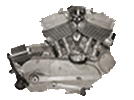 by LDB » Wed Mar 22, 2017 8:40 pm
by LDB » Wed Mar 22, 2017 8:40 pm
Concerning what can happen when a spark plug is installed that is too hot reminds me of what I witnessed back in 1971, which involved a rice burner owned by my friend. However, rice burner or not, and as I learned as time went on, the results can be the same for all gasoline powered, aluminum piston driven, internal combustion engines running plugs that are too hot.
The rice burner was a brand new two-stroke, twin cylinder Yamaha 200. The bike ran fine for a few days and then it started oil fouling the spark plugs. My friend took the bike back to the dealer and asked the Yamaha tech man if maybe the oil injection was set too rich. The tech man said, no, you just need hotter plugs. Turns out, my friend had the correct idea as to the cause of the problem, but being a kid he did not want to argue with the all knowing tech man. So, he installed the hotter plugs as recommended and provided to him by the tech.
After a few days of short runs, no more fouled plugs. Yippee … the Yamaha tech man must be a genius!
The next weekend, a group of us decided to go on a long ride. My friend was eager to ride his new rice burner. In one area of the ride we were on a long straight road and the group reached a fairly good speed of 60 MPH or so. Up ahead, we could see that we were approaching a long steep hill and my friend on his new rice burner wanted to show its power. So he gave it the throttle and took off. As he made it to the top of the hill, he suddenly pulled over to the side of the road and stopped. When the rest of us rode up, one fellow asked what was wrong and he said, “It just quit …” Another guy asked, “Out of gas?” A quick inspection revealed plenty in the tank.
After cooling off for a few minutes, my friend removed the spark plugs and used them to check the ignition with a few kicks of the kick start. The plugs sparked just fine with a strong blue-white spark. The electrodes were clean and the insulators were white looking, which no one thought was odd as the plugs were new. What we didn’t notice at the time is they were a little too white!!
My friend put the plugs back in and tried to start the engine. When he applied the electric starter, the engine turned over nearly 3 times as fast as normal it seemed and would not start. Everyone thought how weird. Another guy said, “Try the kick start just for the hell of it.” So my friend gave it a few kicks and the engine turned over with such ease it looked ridiculous. It obviously had no compression.
So one of the guys pulled out a piece of rope from one of his saddle bags and tied it to the rice burner and the other end to his bike and then proceeded to tow my friend home. Once there, warranty or no warranty, out came the tools and the heads were removed. At this point many of you already know what the inspection revealed … Yup, you guessed it … there was a hole melted in both pistons!!!
The engine was a victim of pre-ignition! The spark plugs had gotten hot enough to glow and ignite the fuel mixture before the spark plugs sparked. And unlike the audible sound that occurs with detonation, pre-ignition is hardly detectable before it occurs, so you won’t hear it and the damage is done. That’s why pre-ignition is so insidious.
Since pre-ignition occurs before TDC, the burning combustion is expanding but is being squeezed or compressed at the same time by a piston still on the rise and the combustion is fighting back, so to speak. This induces extremely rapid combustion and temperatures hot enough to weld. Melt down may be only seconds away!!! Yes, you heard right … seconds.
The moral to this story is never screw in a spark plug just because it fits the hole, is the right length and sparks. Find out about its estimated heat range in advance! Then proceed with caution until you determine what’s best for your particular riding habits and engine set up.
